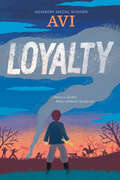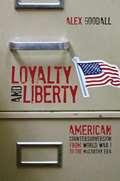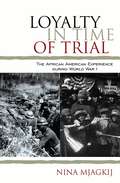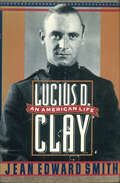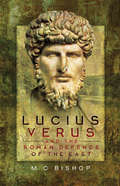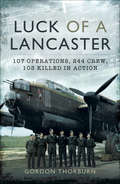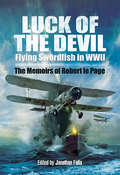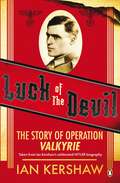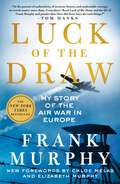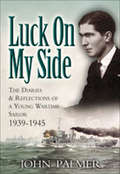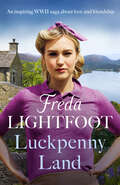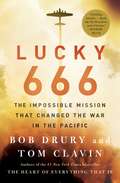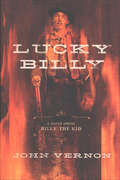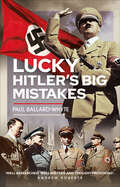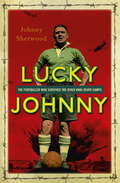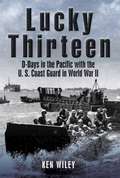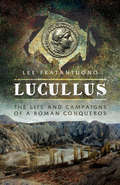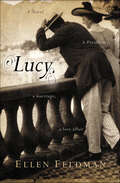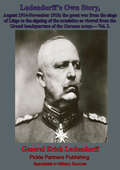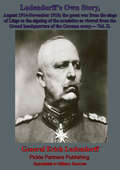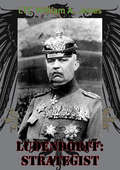- Table View
- List View
Loyalty
by AviNewbery Medalist Avi explores the American Revolution from a fresh perspective in the story of a young Loyalist turned British spy navigating patriotism and personal responsibility during the lead-up to the War of Independence.When his father is killed by rebel vigilantes, Noah flees with his family to Boston. Intent on avenging his father, Noah becomes a spy for the British and firsthand witness to the power of partisan rumor to distort facts, the hypocrisy of men who demand freedom while enslaving others, and the human connections that bind people together regardless of stated allegiances. Awash in contradictory information and participating in key events leading to the American Revolution, Noah must forge his own understanding of right and wrong and determine for himself where his loyalty truly lies.
Loyalty First: The Life and Times of Charles A. Willoughby, MacArthur's Chief Intelligence Officer
by David A. FoyFinalist, 2023 Army Historical Foundation Distinguished Writing Awards" ...provides critical texture to a historical figure often left pilloried without full context. The balanced treatment of a complex, flawed leader is valuable to understanding MacArthur’s command and an instructive lesson for today’s intelligence professionals and those who rely on intelligence to guide their decisions." — Aether: A Journal of Strategic Airpower & Spacepower Major General Charles A. Willoughby served as Douglas MacArthur's stalwart chief intelligence officer (G-2} for over a decade, throughout World War II and the Korean War. This first full biography examines Willoughby's shadowy origins in his native Germany, his curious arrival in the United States, and his military service in World War I, as well as his work during the interwar years as a junior diplomat, budding historian, and neophyte intelligence officer. His chance encounter with MacArthur in the mid-1930s would prove to be the genesis of a near-symbiotic relationship between the two, with significant consequences for both. Throughout his life, Willoughby identified with strong, authoritarian leaders, notably Franco, and—especially—MacArthur. The author also assesses Willoughby's performance as a professional intelligence officer both in World War II and Korea, where he is often vilified for his inaccurate assessments of enemy strength and most likely courses of action, as well as his sycophantic relationship with his commander. Willoughby is most often criticized for his failing to foresee the entry of Chinese forces into the Korean War and its impact upon the US Army and the prosecution of the war. Following MacArthur’s removal by President Truman in 1951, Willoughby retired and spent the rest of his days engaged in right-wing political activity and in staunchly defending his much-maligned boss. The legacy he left is one filled with lingering and important questions about loyalty to superiors, in civilian as well as military environments, how far that loyalty should extend, and walking the tightrope involved in telling truth to power.
Loyalty and Liberty: American Countersubversion from World War 1 to the McCarthy Era
by Alex GoodallLoyalty and Liberty offers the first comprehensive account of the politics of countersubversion in the United States prior to the McCarthy era. Alex Goodall traces the course of American countersubversion over the first half of the twentieth century, culminating in the rise of McCarthyism and the Cold War. This sweeping study explores how antisubversive fervor was dampened in the 1920s in response to the excesses of World War I, transformed by the politics of antifascism in the Depression era, and rekindled in opposition to Roosevelt's ambitious New Deal policies in the later 1930s and 1940s. Varied interest groups such as business tycoons, Christian denominations, and Southern Democrats as well as the federal government pursued their own courses, which alternately converged and diverged, eventually consolidating into the form they would keep during the Cold War. Rigorous in its scholarship yet accessible to a wide audience, Goodall's masterful study shows how the opposition to radicalism became a defining ideological question of American life.
Loyalty in Time of Trial: The African American Experience During World War I (The African American Experience Series)
by Nina MjagkijThe little-known history of black soldiers and defense workers in the First World War, and what happened afterward: &“Highly recommended.&” —Choice In one of the few book-length treatments of the subject, historian Nina Mjagkij conveys the full range of the African American experience during the &“Great War.&” Prior to World War I, most African Americans did not challenge the racial status quo. But nearly 370,000 black soldiers served in the military during the war, and some 400,000 black civilians migrated from the rural South to the urban North for defense jobs. Following the war, emboldened by their military service and their support of the war on the home front, African Americans were determined to fight for equality—but struggled in the face of indifference and hostility in spite of their combat-veteran status. America would soon be forced to confront the impact of segregation and racism—beginning a long, dramatic reckoning that continues over a century later. &“Painstakingly describes the frustration, sometimes anger, and frequent courage demonstrated by southern and northern African Americans in their attempts to include themselves in the national crusade of making the world safe for democracy . . . one of the most comprehensive treatments of the race issue in the early twentieth century that this reader has seen.&” —Journal of Southern History
Lucius D. Clay: An American Life
by Jean Edward SmithSoldier, statesman, logistical genius: Lucius D. Clay was one of that generation of giants who dedicated their lives to the service of this country, acting with ironclad integrity and selflessness to win a global war and secure a lasting peace. A member of the Army's elite Corps of Engineers, he was tapped by FDR in 1940 to head up a crash program of airport construction and then, in 1942, Roosevelt named him to run wartime military procurement. For three years, Clay oversaw the requirements of an eight-million-man army, setting priorities, negotiating contracts, monitoring production schedules and R&D, coordinating military Lend-Lease, disposing of surplus property-all without a breath of scandal. It was an unprecedented job performed to Clay's rigorous high standards. As Eliot Janeway wrote: "No appointment was more strategic or more fortunate."If, as head of military procurement, Clay was in effect the nation's economic czar, his job as Military Governor of a devastated Germany was, as John J. McCloy has phrased it, "the nearest thing to a Roman proconsulship the modern world afforded." In 1945, Germany was in ruins, its political and legal structures a shambles, its leadership suspect. Clay had to deal with everything from de-Nazification to quarrelsome allies, from feeding a starving people to processing vast numbers of homeless and displaced. Above all, he had to convince a doubting American public and a hostile State Department that German recovery was essential to the stability of Europe. In doing so, he was to clash repeatedly with Marshall, Kennan, Bohlen, and Dulles not only on how to treat the Germans but also on how to deal with the Russians. In 1949, Clay stepped down as Military Governor of Germany and Commander of U.S. Forces in Europe. He left behind a country well on the way to full recovery. And if Germany is today both a bulwark of stability and an economic and political success story, much of the credit is due to Clay and his driving vision.Lucius Clay went on to play key roles in business and politics, advising and working with presidents of both parties and putting his enormous organizing skills and reputation to good use on behalf of his country, whether he was helping run Eisenhower's 1952 campaign, heading up the federal highway program, raising the ransom money for the Bay of Pigs prisoners, or boosting morale in Berlin in the face of the Wall. The Berliners in turn never forgot their debt to Clay. At the foot of his West Point grave, they placed a simple stone tablet: Wir Danken Dem Bewahrer Unserer Freiheit- We Thank the Defender of Our Freedom.
Lucius Shepard SF Gateway Omnibus: Green Eyes, The Jaguar Hunter, Vacancy
by Lucius ShepardLucius Shepard's work ranges across the fields of fantasy, science fiction and magic realism, garnering comparisons with Joseph Conrad, Graham Greene and Gabriel Garcia Marquez. Best-known for the story suite The Dragon Griaule - available as a Gollancz Fantasy Masterwork - he has won or been nominated for every major SFF award.This omnibus collects his ARTHUR C. CLARKE AWARD-shortlisted novel GREEN EYES, WORLD FANTASY AWARD-winning collection THE JAGUAR HUNTER and SHIRLEY JACKSON AWARD-winning novella VACANCY.
Lucius Verus and the Roman Defence of the East
by M.C. Bishop&“The first biography of Marcus Aurelius&’ adopted brother and co-emperor . . . a valuable read for anyone with an interest in Roman history.&”—The NYMAS Review Lucius Verus is one of the least regarded Roman emperors, despite the fact that he was co-ruler with his adoptive brother Marcus Aurelius for nine years until his untimely death. The later sources were strangely hostile to him and modern writers tend to dismiss him, but contemporary writings shine a more favorable light on his accomplishments. His handling of military affairs, particularly the conflict with Parthia after their invasions of Armenia and Syria, deserves a new consideration in the light of a careful reassessment of all the available source material. This volume looks at the upbringing of the boy who lost two fathers, acquired a brother, had his name changed twice, became a general overnight, and commanded the army that defeated one of Rome&’s greatest foes in the 2nd century AD. His rise to power is placed in the context of Rome&’s campaigns in the East and the part played by all—from the ordinary soldiers up to the aristocracy who commanded them—in making Lucius Verus&’s Parthian Wars a success. &“Bishop&’s background is in Roman military archaeology, and where the details of Roman warfare are concerned, he knows his subject matter backwards and forwards . . . For those who wish to understand how the Roman commanders fighting under Verus achieved success in the East, Bishop&’s book can be heartily recommended.&”—Bryn Mawr Classical Review
Luck of a Lancaster: 107 Operations, 244 Crew, 103 Killed in Action
by Gordon ThorburnNo 9 Squadron of Bomber Command converted from the Wellington to the Lancaster in August 1942. W4964 was the seventieth Lanc to arrive on squadron, in mid April 1943. She flew her first op on the 20th, by which time No 9 had lost forty-one of their Lancs to enemy action and another five had been transferred to other squadrons and lost by them. No 9 would soon lose a further thirteen of the seventy. All of the remaining eleven would be damaged, repaired, transferred to other squadrons or training units, and lost to enemy action or crashes except for three which, in some kind of retirement, would last long enough to be scrapped after the war.Only one of the seventy achieved a century of ops or anything like it: W4964 WS-J.Across all squadrons and all the war, the average life of a Lancaster was 22.75 sorties, but rather less for the front-line squadrons going to Germany three and four times a week in 1943 and '44, which was when W4964 was flying her 107 sorties, all with No 9 Squadron and all from RAF Bardney. The first was Stettin (Szczecin in modern Poland), and thereafter she went wherever 9 Squadron went, to Berlin, the Ruhr, and most of the big ops of the time such as Peenemnde and Hamburg. She was given a special character as J-Johnny Walker, still going strong and on September 15 1944, skippered by Flight Lieutenant James Douglas Melrose, her Tallboy special bomb was the only one to hit the battleship Tirpitz.During her career, well over two hundred airmen flew in J. None were killed while doing so, but ninety-six of them died in other aircraft. This is their story, and the story of one lucky Lancaster.
Luck of the Devil: Flying Swordfish in WWII
by Robert le PageRobert le Page flew with the Fleet Air Arm from 1940 to 1945, mostly in 816 Squadron flying carrier-based Fairey Swordfish. He saw action mine-laying off Cherbourg, hunting U-boats, escorting convoys in the North Atlantic and Arctic seas and covering D-Day. Much of his early war years were aboard HMS Dasher and he was lucky to be ashore when the carrier mysteriously exploded and sank in the Clyde. This decimated 816 Squadron which was eventually re-equipped and then worked up to operational readiness to fly from HMS Tracker. His story is full of insights into wartime naval flying. For example when they were tasked with finding and attacking German E Boats they found that in a headwind these powerful boats could outdistance the Stringbag. They devised a plan which was to glide as quietly as possible on their approach to the quarry and power up the engine only seconds before they attacked a plan that was unfortunately unsuccessful. Once when landing in rough weather his aircraft was waved to go round again. With throttle wide open the Swordfish struggled back into the air, but alas the tailhook snagged the top wire of the barrier protecting other parked aircraft. The author remembered staring down from the stalling aircraft to see a terror stricken fitter gazing up at him. Fortunately all survived.
Luck of the Devil: The Story of Operation Valkyrie
by Ian Kershaw'It is now time that something was done. But the man who has the courage to do something must do it in the knowledge that he will go down in German history as a traitor. If he does not, however, he will be a traitor to his own conscience' Colonel Claus von Stauffenberg, July 1944The July 1944 Plot to kill Adolf Hitler was a desperate attempt by a group of senior officers to redeem Germany's honour and end the Second World War. They were heroic because they knew their chances of success were slight and that the result of their failure would undoubtedly be a terrible death. They wanted to leave a message for later generations: that there were Germans who understood the evils of Nazism and were willing to act against it. This extraordinary story is the basis for Bryan Singer's major new film Valkyrie, due to be released in February 2009. Published for the first time as a separate book, Luck of the Devil is taken from Ian Kershaw's bestselling Hitler 1936-1945: Nemesis and is a brilliant account of just what happened in those fateful days at Hitler's Wolf's Lair headquarters, when his opponents came so astonishingly close to assassinating what is one of the modern era's most terrible figures.
Luck of the Draw: My Story of the Air War in Europe
by Frank MurphyThe epic true story of an American hero who flew during WWII, soon to be featured in the upcoming Steven Spielberg and Tom Hanks TV Series, Masters of the Air. <p><p>Beginning on August 17, 1942, American heavy bomber crews of the Eighth Air Force took off for combat in the hostile skies over occupied Europe. The final price was staggering. 4,300 B-17s and B-24s failed to return; nearly 21,000 men were taken prisoner or interned in a neutral country, and a further 17,650 made the ultimate sacrifice. Luck of the Draw is more than a war story. It’s the incredible, inspiring story of Frank Murphy, one of the few survivors from the 100th Bombardment Group, who cheated death for months in a German POW camp after being shot out of his B-17 Flying Fortress. <p><p>Now with a new foreword written by his granddaughter Chloe Melas, of CNN, and daughter Elizabeth Murphy. <p> <b>New York Times Bestseller</b>
Luck on My Side: The Diaries & Reflections of a Young Wartime Sailor 1939–1945
by John PalmerSir John Palmer was at sea for virtually the entire war serving in three ships. During this time he kept a secret diary of events and his reactions and emotions which we are now proud to publish. This book vividly describes the author's many wartime exploits. For the worst period of the Battle of the Atlantic, he was on convoy protection duty in the Corvette HMS Clematis and recalls the famous Christmas Day action against the mighty German battle cruiser Hipper.Sadly Sir John died very recently, after a most distinguished life.
Luckpenny Land: An inspiring WWII saga about love and friendship (Luckpenny Land)
by Freda LightfootCan she overcome her family’s doubts to achieve her dream?Meg Turner has a hard life. She lives on a lonely farm in the Lake District and her only company is her bully of a father and her brother, who resents her. They want to keep her at home, but Meg is desperate for more. She finds comfort in her best friend, Kath, and Lanky Lawson, who is more of a father figure to her than her own. Her true source of hope though, is Lanky’s son, Jack, who she loves and hopes to marry one day. However as war looms on the horizon and the world is thrown into chaos, Meg realises that the only thing she can really count on is the land she loves. She throws herself into tending the farm, but when a stranger arrives in the dale, her world will change forever.A vivid and enchanting saga of Lakeland life in the Second World War, perfect for fans of Katie Flynn and Anna Jacobs.
Lucky 666: The Impossible Mission
by Bob Drury Tom ClavinFrom the authors of the New York Times bestselling The Heart of Everything That Is and Halsey's Typhoon comes the dramatic, untold story of a daredevil bomber pilot and his misfit crew who fly their lone B-17 into the teeth of the Japanese Empire in 1943, engage in the longest dogfight in history, and change the momentum of the War in the Pacific--but not without making the ultimate sacrifice.It is 1942, the Japanese war machine has rolled up nearly all of the Pacific Theater, and American forces are clinging to what little unconquered territory remains. While US Marines claw their way across Guadalcanal, small contingents of US Army Airmen make their way to the lonely, embattled Allied airbase on Papua New Guinea. Their mission: to defend Australia from invasion, harass Japanese supply lines, fly perilous bombing missions over enemy-held strongholds, and make reconnaissance runs to provide intelligence for America's nascent island-hopping campaign. Among these men are the pilot Captain Jay Zeamer and the bombardier Sergeant Joseph Raymond Sarnoski, whose swashbuckling reputations precede them. Zeamer, who cannot convince his superiors to give him his own plane, teams up with Sarnoski to recruit a crew of fellow misfits to rebuild a dilapidated B-17 bomber from spare parts in the base's junkyard. They christen the plane Old 666, naming it from its tail identification numbers. In June 1943, Zeamer and Sarnoski and their crew volunteer for a 1200-mile suicide mission into the heart of the Japanese Empire that may well change the course of the war--but which only one of the two friends will survive. In Lucky 666, Drury and Clavin bring to vivid life one of the last great untold stories of World War II. Featuring personal letters, diaries, US Army Air Force after-action reports, even the translated Japanese Imperial Air Force's official account of the longest dogfight in history, Lucky 666 is a tale of friendship, heroism, and sacrifice set against the horrific backdrop of vicious aerial warfare, wounded crewmates, and a white-knuckle emergency landing in the jungles of New Guinea--a must-read for anyone who loves pulse-pounding narrative nonfiction.
Lucky Billy: A Novel About Billy the Kid
by Susan Wyler John VernonA myth-busting novel about America’s most infamous and beloved outlaw, Billy the Kid, from a critically acclaimed historical novelistAccording to legend, Billy the Kid killed twenty-one men, one for every year of his short life; stole from wealthy cattle barons to give to the poor; and wooed just about every senorita in the American Southwest.In Lucky Billy, John Vernon digs deeply into the historical record to find a truth more remarkable than the legend, and draws a fresh, nuanced portrait of this outlaw’s dramatic and violent life.Billy the Kid met his celebrated end at the hands of Pat Garrett, his one-time carousing partner turned sheriff, who tracked Billy down after the jail break that made him famous. In Vernon’s telling, the crucial event of Billy’s life was the Lincoln County War, a conflict between a ring of Irishmen in control of Lincoln, New Mexico, and a newcomer from England, John Tunstall, who wanted to break their grip on the town. Billy signed on with Tunstall. The conflict spun out of control with Tunstall’s murder, and in a series of revenge killings, an obscure hired gunman called Kid Antrim became Billy the Kid.Besides a full complement of gunfights, jail breaks, and bawdy behavior, Lucky Billy is a provocative picture of the West at a critical juncture between old and new. It is also a portrait of an American icon made human, caught in the middle, more lost than brave, more nadve than principled, more of an accidental survivor than simply the cold-blooded killer of American myth.
Lucky Chance Cowboy (Big Chance Dog Rescue #2)
by Teri Anne StanleyAt Big Chance Dog Rescue, everyone can find a forever homeMarcus Talbott is a soldier through and through, and he's not going to let an injury keep him from his Army unit. Sure, his last mission nearly broke his back, but that's nothing his positive attitude and work ethic can't fix, right? In the meantime, he's got a place on the board at the Big Chance Dog Rescue, and flirting with his friend's sassy sister, Emma, is a welcome distraction.Emma Stern is barely scraping by while working and caring for her elderly grandfather, but she's running out of options—and hope. The last thing she has time for is Marcus and his flirting, sexy as he might be. But every time Emma thinks she's reached the end of her rope, Marcus is there to lend a hand. Maybe there's more to the handsome playboy after all...Big Chance Dog Rescue Series: Big Chance Cowboy (Book 1) Lucky Chance Cowboy (Book 2)Praise for Big Chance Cowboy: "A real page turner with a sexy cowboy you can root for, a sassy heroine you can fall in love with, and an ugly dog that brings them together."—CAROLYN BROWN, New York Times bestselling author "Love...and puppies... Be prepared to fall in love with this cast of characters and this book."—JENNIE MARTS, USA Today bestselling author of the Cowboys of Creedence series "Big Chance Cowboy is a tail-wagging good read. I was hooked from start to finish."—DEBBIE BURNS, acclaimed author of the Rescue Me series "Inspiring... Stanley hits the mark with wonderfully complex, caring characters; catchy dialogue; and lessons in self-esteem, loyalty, and forgiveness."—Publishers Weekly
Lucky Hitler's Big Mistakes
by Paul Ballard-WhyteAdolf Hitler’s Great War military experiences in no way qualified him for supreme command. Yet by July 1940, under his personal leadership the Third Reich’s armed forces had defeated Poland, Czechoslovakia, Holland, Denmark, Norway, Belgium and France. The invasion of Great Britain was a distinct reality following Dunkirk. Hungary, Bulgaria and Romania had become allies along with the acquiescent military powers of Mussolini’s Italy and Franco’s Spain. These achievements prompted Field Marshal Willem Keitel, the Wehrmacht’s Chief of Staff, to pronounce Hitler to be ‘the Greatest Commander of all time’. Storm clouds were gathering, most notably the disastrous decision to tear up the treaty with the Soviet Union and launch Operation Barbarossa in 1941. As described in this meticulously researched and highly readable book, Hitler’s blind ideology, racist hatred and single-mindedness led him and his allies inexorably to devastating defeat. How far was it good luck that gave Hitler his sensational early political and military successes? Certainly fortune played a major role in his survival from many assassination attempts and sex scandals. The author concludes, from 1941 onwards, the Fuhrer’s downfall was entirely attributable to military misjudgments that he alone made. Lucky: Hitler’s Big Mistakes exposes the enigmatic Dictator for what he really was – incredibly lucky and militarily incompetent.
Lucky Johnny: The Footballer who Survived the River Kwai Death Camps
by Johnny SherwoodIn 1938 Johnny Sherwood was a young professional footballer on the brink of an England career, touring the world with the all-star British team the Islington Corinthians. By 1942 he was a soldier surrendering to the Japanese at the siege of Singapore. Taken prisoner he was sent to a POW camp deep in the heart of the Thai jungle, where he was starved, beaten, and forced to build the notorious 'railway of death' on the River Kwai. Johnny kept his and his men's spirits up with tales of his footballing past, even organising matches until he and the other prisoners became too weak to play. One day, he even encountered a brutal Japanese guard, and was shocked to recognise him as a Japanese footballer Johnny had played against. Many years after Johnny's death, his grandson Michael discovered an old manuscript hidden in the attic of his mother's house. It was Johnny's own account of his wartime experiences - the story too horrific to reveal in full to his loved ones. In the tradition of bestselling memoirs like The Railway Man, Lucky Johnny is an inspirational tale of survival against the odds.
Lucky Johnny: The Footballer who Survived the River Kwai Death Camps
by Johnny SherwoodIn 1938 Johnny Sherwood was a young professional footballer on the brink of an England career, touring the world with the all-star British team the Islington Corinthians. By 1942 he was a soldier defending Singapore against the Japanese. Taken prisoner he was sent to a POW camp deep in the heart of the Thai jungle, where he was starved, beaten, and forced to build the notorious 'railway of death' on the River Kwai. Johnny kept his and his men's spirits up with tales of his footballing past, even organising matches until he and the other prisoners became too weak to play. One day, he encountered a brutal Japanese guard, and was shocked to recognise him as a Japanese footballer Johnny had played against. Despite the inhumane treatment he received at the hands of the guards, and the trials the POWs continued to face even after liberation, Johnny's story is an inspirational tale of survival against the odds. Many years after Johnny's death, his grandson Michael discovered an old manuscript hidden in the attic of his mother's house. It was Johnny's own account of his wartime experiences - the story too horrific to reveal to his loved ones. Now, in publishing Johnny's memoirs, Michael is finally fulfilling Johnny's wish that the world should know the truth about his traumatic time as a POW, and his long journey back to civilisation.
Lucky Thirteen: D-Days in the Pacific with the U. S. Coast Guard in World War II
by Ken WileyThis story is about the U .S. Coast Guard's role in World War II, as told from the perspective of a teenage boy who played a part in that great global struggle. It is also about an unheralded boat that played an insignificant and yet very important role in America's response to restoring freedom to a part of the world enslaved by an evil tyranny. Lucky 13--my boat--was a weapon specifically designed and mass produced in the United States to bridge the 6,000-mile ocean gap and carry the war to the shores of the enemy. The "Higgins" boats were lowered from troop ships with one mission: to carry the infantry and equipment the last seven miles of the long and perilous journey onto the beaches of enemy-held islands.
Lucullus: The Life and Campaigns of a Roman Conqueror
by Lee FratantuonoThe military achievements of Lucius Licinius Lucullus (118-57/56 B.C.) have been the subject of admiration and great respect throughout the history of the study of warfare. Yet there have been few studies dedicated to a comprehensive examination of exactly how Lucullus conquered the Roman East and made it a more or less cohesive part of the empire. Lee Frantantuono considers every aspect of Lucullus life, starting with the training and education of a future Roman officer, but the greatest emphasis is on his military strategy and tactics during the Third Mithridatic War and his military adventures in Armenia. His most famous achievement was his victory against immense odds at the land battle of Tigranocerta. We are also reminded that he one of the most formidable naval strategists of the Roman Republic. Lucullus complicated relationship with Sulla and Crassus is explored and the study concludes with the retirement of the man Pliny the Elder memorably referred to as 'Xerxes in a Toga', a patron of the arts and master of a life of horticulture and reflection.
Lucy: A Novel
by Ellen FeldmanAn utterly absorbing novel about a famous political marriage and an epic infidelity. On the eve of World War I, Assistant Secretary of the Navy Franklin Delano Roosevelt, fiercely ambitious and still untouched by polio, falls in love with his wife's social secretary, Lucy Mercer. Eleanor stumbles on their letters and divorce is discussed, but honor and ambition win out. Franklin promises he will never see Lucy again. But Franklin and Lucy do meet again, and again they fall in love. As he prepares to run for an unprecedented third term and lead America into war, Franklin turns to Lucy for the warmth and unconditional approval Eleanor is unable to give. Ellen Feldman brings a novelist's insight to bear on the connection of these three compelling characters. Franklin and Lucy did finally meet, across the divide of his illness and political ascendancy, her marriage and widowhood. They fell in love again. As he prepared to run for an unprecedented third term and lead America into war, Franklin turned to Lucy for the warmth and unconditional approval Eleanor was unable to give. Drawing on recently discovered materials to re-create the voice of a woman who played a crucial but silent role in the Roosevelt presidency, Lucy is a remarkably sensitive exploration of the private lives behind a public marriage. Reading group guide included.
Ludendorff's Own Story, August 1914-November 1918 The Great War - Vol. I: from the siege of Liège to the signing of the armistice as viewed from the Grand headquarters of the German army (Ludendorff's Own Story #1)
by Anon Anon General Erich Friedrich Wilhelm LudendorffAs the German army moved swiftly into its start positions at the beginning of the First World War, efficiently and seamlessly forming up for the hammer blow that was to fall on France it must have been with some pride that General Ludendorff would look upon the first grand strategical plan that he had a hand in. A cool, calculating planner dedicated to ensuring that chance played as little a part in war as possible General Erich Ludendorff was the product of the prestigious German Kriegsakademie. His memoirs on the First World War are an excellently detailed account of the planning and execution of the ambitious German High command and their thirst for VictoryAlthough known primarily as staff officer his initial service, in the German army, during the war, was at the siege of Liège for which he was awarded the coveted Pour La Mérite by the Kaiser himself. He was rushed to the embattled Eastern Front as Chief of Staff to General von Hindenburg, and the two made an impressive team winning that battles of Tanneburg and the Masurian Lakes. Once again Ludendorff, this time was his chief Hindenburg, was drafted in as a replacement to ensure the fortunes of the German forces, this time on the Western front in 1916. He operated as the prime mover in the German empire from this point until the end of the war; masterminding the 1918 offensives as the last throw of the dice before capitulation.This first volume covers his early career until 1917 and is enriched with maps of the campaigns of the First World War.Author -- General Erich Friedrich Wilhelm Ludendorff, 1865-1937.Translator -- Anon.Text taken, whole and complete, from the edition published in New York and London, Harper & Brothers, 1919.Original Page Count - 477 pages
Ludendorff's Own Story, August 1914-November 1918 The Great War - Vol. II: from the siege of Liège to the signing of the armistice as viewed from the Grand headquarters of the German army (Ludendorff's Own Story #2)
by Anon Anon General Erich Friedrich Wilhelm LudendorffAs the German army moved swiftly into its start positions at the beginning of the First World War, efficiently and seamlessly forming up for the hammer blow that was to fall on France it must have been with some pride that General Ludendorff would look upon the first grand strategical plan that he had a hand in. A cool, calculating planner dedicated to ensuring that chance played as little a part in war as possible General Erich Ludendorff was the product of the prestigious German Kriegsakademie. His memoirs on the First World War are an excellently detailed account of the planning and execution of the ambitious German High command and their thirst for VictoryAlthough known primarily as staff officer his initial service, in the German army, during the war, was at the siege of Liège for which he was awarded the coveted Pour La Mérite by the Kaiser himself. He was rushed to the embattled Eastern Front as Chief of Staff to General von Hindenburg, and the two made an impressive team winning that battles of Tanneburg and the Masurian Lakes. Once again Ludendorff, this time was his chief Hindenburg, was drafted in as a replacement to ensure the fortunes of the German forces, this time on the Western front in 1916. He operated as the prime mover in the German empire from this point until the end of the war; masterminding the 1918 offensives as the last throw of the dice before capitulation.This second volume covers from 1917 until the end of the War and is enriched with maps of the campaigns of the First World War.Author -- General Ludendorff, Erich Friedrich Wilhelm, 1865-1937.Translator -- Anon.Text taken, whole and complete, from the edition published in New York and London, Harper & Brothers, 1919.Original Page Count - 473 pages
Ludendorff: Strategist
by LTC William A. JonesOne of the techniques to understanding the successful choreography of the elements of strategy is the study of the great strategists of history. This worthy endeavor, however, should not be limited to the study of success. Many significant lessons concerning the components of strategy can only be derived from studying the examples of great strategic failure. Erich Ludendorff failed as a strategic leader. This case study traces the genesis of his failure in the context of his inability to properly coordinate the elements of strategy. It is an analysis of the process which led to his failure. An appreciation of his background and heritage reveals the nature of his values and prejudices which accompanied him to the strategic level. An analysis of his strategic development links his character with his personal experiences at the different levels of leadership. Finally an essay of his work as a strategic leader is diagrammed in terms of his character, his development and the strategic environment of the times. Collectively, this diversified group of inputs, some complimentary, others often in direct competition, serve to identify the base from which his strategic decisions were made. The value of this study becomes apparent as the errors suddenly become glaring and the student finds himself learning from the strategic solution that in fact led to failure.
